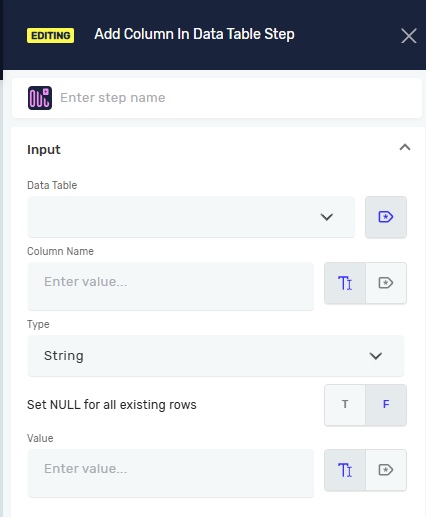Add Column In Data Table Step
Brief description
This step adds a new column to an existing data table variable.
It allows users to extend the data table structure dynamically during automation execution.
The new column can be configured with a specific name, data type, and default value for existing rows.
Step Information
Step name (Not required) – the custom name of the process step that labels the editor’s process step box
Input parameters
- Data Table (Required) – specifies the existing data table variable where the new column will be added.
- Column Name (Required) – defines the name of the new column to be created.
- Type (Required) – specifies the data type of the new column.The available data types are:
- Integer – for whole numbers
- Decimal – for numbers with decimal places
- Boolean – for true/false values
- String – for text values (can be set to NULL)
- DateTime – for date and time values
- Set NULL for all existing rows (Required) – determines whether the new column should be initialized with NULL values for all existing rows. (Available only for String type)
- T (true) – sets all existing rows in the new column to NULL (only applicable for String type).
- F (false- default value) – allows you to define a specific value for all existing rows.
- Value (Required) – defines the value that will be assigned to the new column in all existing rows. For all types except String, this value must be explicitly defined (NULL is not allowed). Required when Set NULL = False
Output parameters
This step does not produce output parameters.
Additional comments
This step is used to expand the structure of a data table dynamically during workflow execution. The Set NULL option is available only when the new column’s data type is String; for all other types, a default value must be specified.
If Set NULL is set to False, the Value field must be filled with the initial data that will populate the new column across all existing rows.
This ensures consistent data initialization and prevents incomplete records in the table.

